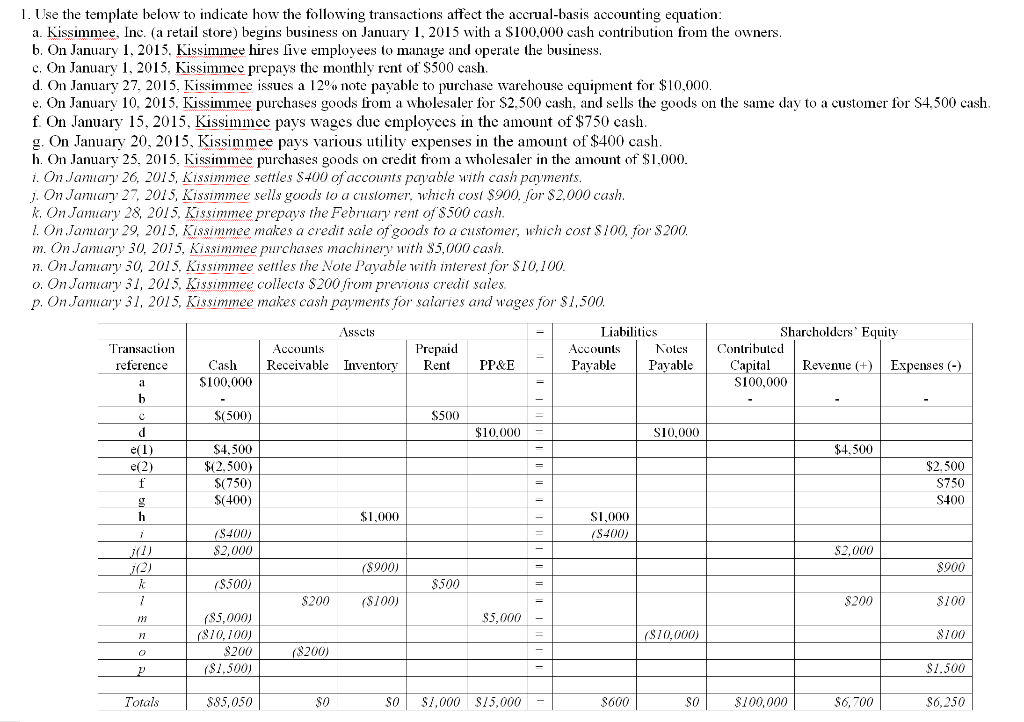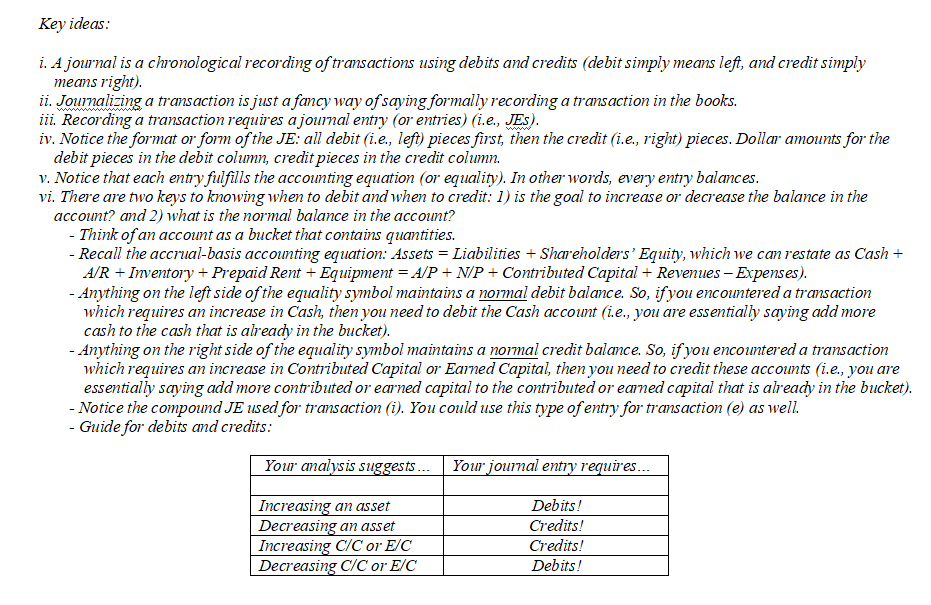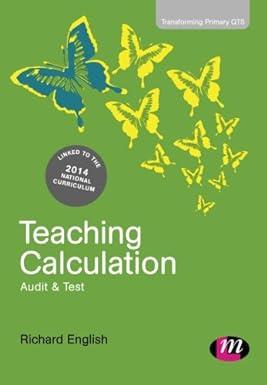Use the following image to answer the question
QUESTION:
The property, plant and equipment account normally maintains a credit balance.
o True
o False



1. Use the template below to indicate how the following transactions affect the accrual basis accounting equation: a. Kissimmee, Inc. (a retail store) begins business on January 1, 2015 with a $100,000 cash contribution from the owners. b. On January 1, 2015, Kissimmee hires live employees to manage and operate the business. c. On January 1, 2015, Kissimmee prepays the monthly rent of $500 cash. d. On January 27, 2015, Kissimmee issues a 129 note payable to purchase warehouse equipment for $10,000. e. On January 10, 2015, Kissimmee purchases goods from a wholesaler for $2,500 cash, and sells the goods on the same day to a customer for S4,500 cash. f. On January 15, 2015, Kissimmee pays wages due employees in the amount of $750 cash. g. On January 20, 2015, Kissimmee pays various utility expenses in the amount of $400 cash. h. On January 25, 2015. Kissimmee purchases goods on credit from a wholesaler in the amount of $1,000. 1. On January 26, 2015, Kissimmee settles $400 of accounts payable with cash payments. j. On January 27, 2015, Kissimmee sells goods to a customer, which cost $900. for $2.000 cash. k. On January 28, 2015, Kissimmee prepays the February rent of $500 cash. 1. On Jamary 29, 2015, Kissimmee makes a credit sale of goods to a customer, which cost $700, for $200. m. On Jamiary 30, 2015, Kissimmee purchases machinery with $5,000 cash. n. On January 30, 2015. Kissimmee settles the Note Payable with interest for $10,100. 0. On January 31, 2015, Kissimmee collects $200 from previous credil sales. p. On January 31, 2015, Kissimmee makes cash payments for salaries and wages for $1,500. Transaction reference Assets Accounts Receivable Inventory Prepaid Rent Liabilitics Accounts Notes Payable Payable Shareholders' Equity Contributed Capital Revenue (+) Expenses (-) $100,000 PP&E Cash $100,000 2 b $(500) $500 $10.000 S10,000 d d e(1) e(2) f $4,500 $4,500 $2.500) $(750) $(400) $2.500 S750 S400 $1,000 $1,000 h 1 1/1) 1(2) ($400) $2,000 (S400) $2,000 ($900) $900 (S500) $500 1 $200 ($100) $200 $100 131 $5,000 72 ($70,000) ($5,000) ($70.100) $200 ($1.500) O ($200) P $1.500 Totals $85,050 $0 SO $7,000 $75.000 $600 SO $100,000 S6,700 $6,250 2. Prepare the JEs for transactions (a)-(p) above. Ref Account description Debit Credit (a) $100,000 Cash Contributed capital $100,000 (b) $500 (c) Prepaid Rent Cash $500 (d) $10,000 Equipment (PP&E) Note Payable $10,000 (e) $4,500 Cash Revenue $4,500 $2,500 Cost of goods sold Cash $2,500 $750 Wage expense Cash $750 $400 (9) Utility expense Cash $400 $1,000 (h) Inventory Accounts payable $1,000 (i) $4,000 Accounts payable Cash $4,000 (1) $1,500 $ 900 Cash Cost of goods sold Inventory Revenue $ 900 $1,500 $ 500 Prepaid rent Cash $ 500 $ 200 $ 100 Accounts receivable Cost of goods sold Inventory Revenue $ 100 $ 200 $5,000 (m) Property, plant and equipment Cash $5,000 Note payable Interest expense Cash $10,000 $ 100 $10,100 (0) $ 200 Cash Accounts receivable $ 200 $ 1,500 Wage expense Cash $ 1,500 Totals $119,650 $119,650 Key ideas: i. A journal is a chronological recording of transactions using debits and credits (debit simply means left, and credit simply means right). ii. Journalizing a transaction is just a fancy way of saying formally recording a transaction in the books. iii. Recording a transaction requires a journal entry (or entries) (i.e., JES). iv. Notice the format or form of the JE: all debit (i.e., left) pieces first, then the credit (i.e., right) pieces. Dollar amounts for the debit pieces in the debit column, credit pieces in the credit column. v. Notice that each entry fulfills the accounting equation (or equality). In other words, every entry balances. vi. There are two keys to knowing when to debit and when to credit: 1) is the goal to increase or decrease the balance in the account? and 2) what is the normal balance in the account? - Think of an account as a bucket that contains quantities. - Recall the accrual-basis accounting equation: Assets = Liabilities + Shareholders' Equity, which we can restate as Cash + A/R + Inventory + Prepaid Rent + Equipment = A/P + N/P + Contributed Capital + Revenues Expenses). - Anything on the left side of the equality symbol maintains a normal debit balance. So, if you encountered a transaction which requires an increase in Cash, then you need to debit the Cash account (i.e., you are essentially saying add more cash to the cash that is already in the bucket). - Anything on the right side of the equality symbol maintains a normal credit balance. So, if you encountered a transaction which requires an increase in Contributed Capital or Earned Capital, then you need to credit these accounts (i.e., you are essentially saying add more contributed or earned capital to the contributed or earned capital that is already in the bucket). - Notice the compound JE used for transaction (i). You could use this type of entry for transaction (e) as well. - Guide for debits and credits: Your analysis suggests ... Your journal entry requires... Increasing an asset Decreasing an asset Increasing C/C or E/C Decreasing C/C or E/C Debits! Credits! Credits! Debits









